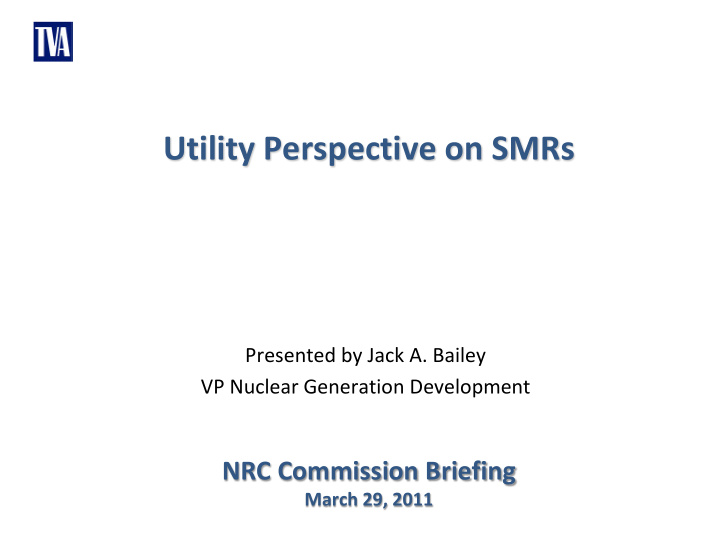



Utility Perspective on SMRs Presented by Jack A. Bailey VP Nuclear Generation Development NRC Commission Briefing March 29, 2011
TVA’s Renewed Vision Reflects Interests of Many Utilities Provide Cleaner Low-Cost Power Cleaner Air High Reliability Greater Energy Low Rates Efficiency Responsible More Nuclear Stewardship Generation Coal Nuclear Hydro Gas/Oil FY2020 Generation FY2010 Generation 2 Renewables/EE
Small Modular Reactors Potential Benefits Simplified “passive safety” LWR Underground containment and used fuel storage Four years or more between refuelings Shop fabricated, rail shipped Incremental generation when and where its needed Lower transmission system impacts 3
SMR Challenges Overcoming economy of scale challenges. – Regulations and industry practices designed for larger plants. Realizing goal of adding incremental modules efficiently when needed. – License multiple modules before needed, so that can build when needed. Providing adequate and effective manufacturing oversight and inspection 4
Lessons Learned From Advanced Reactor Programs Apply Standardization – Achieve and maintain Design Centered Working Groups – One issue one review – Design specific through industry team – Generic issues through NEI Industry Teams – Stay committed through both licensing and construction 5
First Mover Consideration of 10CFR50 versus 10CFR52 10CFR50 is suitable for first-of-a-kind designs Increased potential risk of 10CFR50 can be managed by: – Completing substantial engineering prior to construction – Clear identification and early NRC review of critical design features 10CFR50 and 10CFR52 both need to ensure standardization of new designs 10CFR52 clear preference for long-term standardized deployment 6
Time Is Now CY CY CY CY CY CY CY CY CY CY CY 2011 2012 2013 2014 2015 2016 2017 2018 2019 2020 2021 Clinch River Project – 10CFR50 Process Prepare CPA Submit CPA PSAR NRC CPA Review ER Construction Permit Issuance CP DSER Prepare Operating License Application Submit OL Application NRC Review Operating License Applic. 1 st Unit FSER Issued Pre-Op Start-up Testing Testing mPower DCD and COLA – 10CFR52 Process Operating license Issuance Fuel Load Prepare Design Certification Application DCA Scope Freeze Submit DCA NRC DCA Review (36 mos. To FSER) FSER Issued DC Rule Final DC Rulemaking 7
Main Discussion Points Many articulated reasons for considering SMRs along with larger ALWRs. While similar in design to large reactors, large margins to safety expected to be met with simpler and fewer plant systems. Industry working with NRC to right size certain regulatory requirements commensurate with the risk of SMRs, using lessons learned from advanced new plant activities. Successful navigation among the possible regulatory paths just as critical to successful deployment of SMRs as managing total construction costs. 8
Recommend
More recommend